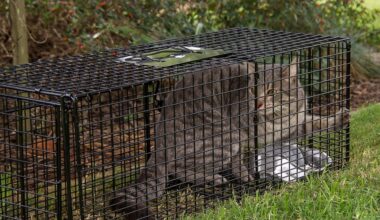Best Diet Plans for Weight Management in Cats
Preventing obesity in cats is crucial for ensuring their overall health and longevity. One of the most effective strategies is implementing a structured diet plan specifically tailored for weight management. Start by consulting your veterinarian to determine an appropriate calorie intake based on your cat’s weight, age, and activity level. Providing high-quality, protein-rich food will not only promote fat loss but also support muscle maintenance. A gradual weight reduction of 1–2% per week is ideal for ensuring that the weight loss is healthy. Besides quantity, consider the quality of the food; select diets that have reduced carbohydrates and higher fiber content to help cats feel full. Many pet owners make the mistake of overfeeding or providing too many treats, leading to weight gain. It’s essential to measure food portions accurately and limit treats to less than 10% of daily calories. Incorporating exercise, such as playtime with toys or interactive games, can further aid weight management. Remember that patience is key; change takes time. Stick to the plan and monitor your cat’s weight regularly to ensure ongoing success.
In addition to monitoring dietary intake, the timing of meals plays a significant role in managing your cat’s weight effectively. Instead of free-feeding, which can encourage overeating, consider establishing a strict feeding schedule. Feeding two or three times a day may help to create a routine for your feline friend, making it easier to manage their calorie intake. Also, pay attention to the type of food being fed; some special formulas are designed specifically for weight management. These foods often contain lower calorie counts while maintaining nutrition. You can also incorporate some wet food into their diet to provide hydration and lower calorie density. Debunk common myths around cat treats; many are high in calories, so opt for healthier alternatives or make your own low-calorie treats at home. Training your cat with blockades in the way of food sources, or engaging them in vigorous play right before mealtime can also help curb their appetite for larger feeds. Consistency in these practices, accompanied by a supportive environment, is essential to facilitate effective weight management and ensure your cat remains healthy and active.
Nutritional Considerations for Cats
The nutritional requirements for maintaining your cat’s health are integral not only for preventing obesity but also for building a strong immune system. Cats are obligate carnivores, meaning their primary diet should consist of animal-based proteins. When selecting a diet plan, prioritize high protein levels, as they promote satiety and muscle preservation during weight loss. Look for foods labeled as ‘complete and balanced’ by recognized authorities. Ingredients should include real meats, fish, and poultry. Avoid those containing excessive fillers like corn and soy, as they provide little nutrition and can lead to increased weight. Ensure that your cat receives adequate amounts of healthy fats, as these are vital for energy and support healthy skin and coats. Omega-3 and Omega-6 fatty acids are especially beneficial. Additionally, incorporating essential vitamins and minerals into their diet supports metabolic processes. Regularly reviewing ingredient labels will help you make informed decisions about your cat’s diet. Pay attention to weight management formulas that combine appropriate nutrient profiles with lower calorie counts specifically designed for cats needing to shed excess weight and maintain optimal health.
It’s also crucial to establish a healthy lifestyle for your cats that encompasses both diet and physical activity. Encouraging your cat to play and stay active is beneficial for burning calories. Consider engaging them in interactive play with laser pointers, feather toys, or wand toys. Creating a stimulating environment can help combat obesity and keep their minds sharp. Scratching posts, climbing trees, and even puzzle feeders will keep them entertained and encourage physical movement. Ensure your home is safe for exploration while avoiding high-calorie, low-nutrient snacks that could sabotage weight goals. Incorporating different play styles can also enhance mental stimulation. Rotate toys regularly to keep them fresh and interesting. Consider adopting a second cat for companionship, as they often stimulate each other’s activity levels. Always supervise interactions, ensuring they are safe and positive. Remember that each cat is different; some might prefer active play, while others might enjoy exploring around the house. Tailoring activity levels to your cat’s personality ensures a better chance of maintaining their health and weight throughout their life.
Maintaining Weight Loss
Once your cat has achieved a healthy weight, maintaining that weight is equally important. Gradually reintroducing regular feeding while continuing to monitor their weight is key to preventing weight regain. Regularly scheduled vet check-ups can help monitor their health status. Implement a maintenance diet plan that is lower in calories compared to standard options but still nutritionally adequate. Cats, after reaching their target weight, still need careful adjustments to their caloric intake to ensure stability. Regular feedback from your vet can help you tweak your cat’s feeding routines, ensuring they remain fit and healthy. It’s advisable to combine a consistent feeding schedule with engaging physical activity routines tailored to your cat’s preferences for sustainable weight maintenance. Be prepared for any fluctuations and stay vigilant about their condition. Tracking their weight and making adjustments as necessary should be a part of their routine care. Additionally, reinforcing positive behaviors with praise rather than food can mitigate the risk for overindulgence. A focus on lifestyle changes will solidify the result of efforts towards a healthier weight for your feline companion.
Lastly, being aware of and addressing emotional eating in your cats can be a challenging yet essential step in maintaining their weight. Cats may eat due to boredom, stress, or simply because food is available. Observing your cat’s behavior around meal times can offer insight into their eating habits. Establishing a structured routine and predictable feeding times creates an environment of security and helps reduce anxiety-driven eating. Providing mental stimulation through toys or interactive play can also divert attention from food. If your cat is showing signs of eating due to stress, consider consulting with a veterinarian or feline behaviorist to explore solution options. Behavioral interventions, like enrichment activities, can help combat underlying issues that lead to excessive eating. Surveillance can help catch these unhealthy habits early on. Losing track of these behavioral changes can lead to upward trends in weight. Tools like feeding puzzles may also slow down their eating and promote healthier habits, making mealtime more enjoyable! Keep communication open with veterinary staff to facilitate adjustments in their dietary needs or behavioral insights.
Conclusion
In conclusion, preventing obesity in cats is entirely achievable through dedicated diet plans, physical activity, and behavioral monitoring. The guidelines discussed in this article emphasize the importance of structured feeding schedules, high-quality nutrition, and engaging playtime. Weight management in cats should not be an insurmountable challenge but rather a collaborative effort involving careful planning and consistent practices. Regular communication with vets empowers pet owners to adapt their strategies as their cats age or if their health situations change over time. Incorporating healthy lifestyle habits early in your cat’s life makes it easier to maintain weight as they age. The aim is to promote not only weight loss but overall well-being and happiness. Investing in your cat’s health today will lead to a longer and happier life together. Remember that every cat is unique, so adjustments may be required as health needs change. Celebrate small victories while remaining committed to their health journey. With consistent effort, the quality of life for your feline friend can significantly improve, allowing you both to enjoy many years of companionship.
Lastly, ensure you access plenty of resources to assist with your cat’s weight management. Online forums, veterinary guidance, and nutrition-related books can provide inspiration and support. Support groups that focus on overweight pets can be invaluable for sharing experiences and tips that have worked for others. Staying informed about nutritional advancements and discovering innovative food options can further empower your efforts. Moreover, engaging with your local community can offer opportunities for interaction with fellow cat enthusiasts. Always remember that weight management is a long-term commitment and should not be rushed. Be prepared to adapt strategies based on your cat’s progression and unique needs. You’re not alone in this journey, and many have faced similar challenges while working towards healthier diets for their pets. Combining personal insights with general advice will greatly contribute to the understanding of cat obesity and its prevention. As you navigate this journey, it’s essential to acknowledge your accomplishments and remain patient, as every small step contributes significantly to achieving your health goals for your beloved feline.


